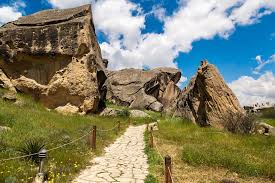Gobustan, located in Azerbaijan, is renowned for its UNESCO World Heritage-listed rock art and archaeological sites. Gobustan is a treasure trove of prehistoric rock carvings, mud volcanoes, and ancient artifacts dating back thousands of years. The petroglyphs found here depict scenes of hunting, dancing, rituals, and daily life from the Stone Age to the Bronze Age, offering a fascinating glimpse into early human civilization in the region. Gobustan's unique landscapes and historical significance make it a must-visit destination for history enthusiasts and travelers exploring Azerbaijan's rich cultural heritage.
The History of Gobustan
The history of Gobustan is renowned for its ancient rock art and archaeological significance. The area is home to more than 6,000 rock engravings dating back between 5,000 to 40,000 years, depicting scenes of hunting, dancing, rituals, and daily life of ancient inhabitants.The history of Gobustan offers a fascinating glimpse into the cultural and artistic heritage of early human societies in the region. The history of Gobustan extends beyond its rock art, with evidence of human habitation from the Upper Paleolithic period, making it a UNESCO World Heritage Site and a key destination for archaeological study and cultural tourism in Azerbaijan.
The Nature of Gobustan – Aristokrat Travel
The nature of Gobustan offers visitors a journey through time. Located on the Absheron Peninsula, this UNESCO World Heritage Site captivates with its ancient rock carvings, mud volcanoes, and diverse wildlife. The petroglyphs, dating back over 12,000 years, provide a glimpse into prehistoric human life and rituals, while the surrounding landscape of rugged mountains and semi-arid plains creates a dramatic backdrop for exploration. The nature of Gobustan is not just a place of historical significance but also a sanctuary where the essence of Azerbaijan's natural beauty and ancient history converge, inviting travelers to delve into its mysteries and marvels. Meanwhile, the bubbling mud volcanoes dotting the terrain add an otherworldly charm, spewing mud and gases amidst a backdrop of arid hills and desert flora.
Cultural Heritage in Gobustan
Cultural heritage in Gobustan is particularly its ancient rock carvings and mud volcanoes. The Gobustan Rock Art Cultural Landscape, a UNESCO World Heritage Site, features over 6,000 rock engravings depicting scenes of hunting, dancing, and rituals dating back to 40,000 years ago. These petroglyphs provide valuable insights into the prehistoric lives of the region's inhabitants. Additionally, cultural heritage in Gobustan is home to numerous mud volcanoes, adding to its unique geological and cultural significance, making it a compelling destination for archaeologists, historians, and nature enthusiasts alike.


 Golf Club
Golf Club
 DMC in Azerbaijan
DMC in Azerbaijan
.png) Hunting in Azerbaijan - Hunting Tours in Azerbaijan
Hunting in Azerbaijan - Hunting Tours in Azerbaijan
.png) Azerbaijan Hotel Booking – Baku hotel Booking
Azerbaijan Hotel Booking – Baku hotel Booking
.png) Tour Guide in Azerbaijan
Tour Guide in Azerbaijan
 Transfer
Transfer